Oooh, nice; I wondered what you meant when you said it was scultped. Cool workflow; is 3ds max rendering those shadows in the viewport?Thanks guys, not sure where I'm getting with it, more experiments will be made.
Some people asked about a wire and breakdown of the 2nd robot, you can check it out here: http://i.imgur.com/hXswUiu.jpg
You are using an out of date browser. It may not display this or other websites correctly.
You should upgrade or use an alternative browser.
You should upgrade or use an alternative browser.
Indie Game Development Discussion Thread | Of Being Professionally Poor
- Thread starter chubigans
- Start date
- Status
- Not open for further replies.
BlastProcessing
Member
Getting really close to the finish line. I have been cutting trailers and putting together marketing stuff for the last few days. One of my favorite Gifs:


Getting really close to the finish line. I have been cutting trailers and putting together marketing stuff for the last few days. One of my favorite Gifs:

Your game looks very familiar. Were you at SXSW per chance? I feel like I've played this some where...
EDIT: Where are my manners, of course this looks great! Love the orbit effects.
BlastProcessing
Member
Your game looks very familiar. Were you at SXSW per chance? I feel like I've played this some where...
EDIT: Where are my manners, of course this looks great! Love the orbit effects.
We were at SXSW! In the indie alley. We had a dancing animatronic spider and everything. I wonder, did we chat? That whole week is a blur for me.
Thanks for the kind words.
We were at SXSW! In the indie alley. We had a dancing animatronic spider and everything. I wonder, did we chat? That whole week is a blur for me.
Thanks for the kind words.
That was it, then! I don't remember if we chatted or not haha. That week was quite a blur for me as well. But, anyways. I look forward to playing the completed game...this month, right? Good luck with the final push!
Looking for a programmer to help me with a 2D endless runner on Unity. I've been surfin the Unity/TIG Forums and not finding the person I'm looking for. Thought I would try and find someone here! I'm paying hourly. PM me if you're lookin for some work.
I would have probably jumped at this a week ago. I start a new non-game related contract in like a week so no chance for me.
Nice to be back. I've been away for some time. Nice to see that you guys keep showing awsome stuff.
I've been quite busy working on a c++ multiplaform engine that I'm using to develop my next game, that I'll realease soon on iOS and Android. It's a simple game, nothing extraordinary.
Meanwhile, I also have some great news to share soon for all Snails fans ( which are non existent). I'll post here in a few days.
Cheers!
I've been quite busy working on a c++ multiplaform engine that I'm using to develop my next game, that I'll realease soon on iOS and Android. It's a simple game, nothing extraordinary.
Meanwhile, I also have some great news to share soon for all Snails fans ( which are non existent). I'll post here in a few days.
Cheers!
Meatyhooks
Neo Member
As someone who is completely ignorant to game design this tread is awesome.
No, I rendered with a mix of ambient occlusion and shadowmap lights. Also using a pretty old 3Ds max version.Oooh, nice; I wondered what you meant when you said it was scultped. Cool workflow; is 3ds max rendering those shadows in the viewport?
Implementing some more save game stuff. Ideally instead of separate Save and Load methods I'd like to have a single serialization method.
For simple stuff I can just pass in a variable by reference and have it do the right thing. But haven't nailed down the best way to deal with collections (tables, maps, lists) yet though.
For simple stuff I can just pass in a variable by reference and have it do the right thing. But haven't nailed down the best way to deal with collections (tables, maps, lists) yet though.
Just starting to develop my next title. It's called Plander. Very little has been done so far, but I've got some rough gameplay, sfx, and music that I've worked up in this video:
Plander Development Video
I don't plan to post these here every time - that would be obnoxious - but I thought it would be fun to post something since I haven't shown anything I've made in the thread yet. Time to make an offering!
Plander Development Video
I don't plan to post these here every time - that would be obnoxious - but I thought it would be fun to post something since I haven't shown anything I've made in the thread yet. Time to make an offering!
http://www.newgrounds.com/portal/view/270585
Did BIT Trip Runner blatantly rip off this game?
I don't know, as I haven't even played BIT Trip. But when I saw the newgrounds link, that was the first game I thought it could be. Perhaps because I know the artist (Jermz) and he recently released a spiritual sequel https://play.google.com/store/apps/details?id=com.omegaBitz.RGB_Test
http://www.newgrounds.com/portal/view/270585
Did BIT Trip Runner blatantly rip off this game?
It's an autorunner... I mean, there are some similarities, like the slide ability and the fact that there simply are other abilities, but it's not really that much like RUNNER at all. The color shifting mechanic sets it apart for sure, there's nothing like that in RUNNER. It's like saying Sonic ripped off Mario. They're similar, and this is possibly even the source for inspiration, but it's very different.
It's an autorunner... I mean, there are some similarities, like the slide ability and the fact that there simply are other abilities, but it's not really that much like RUNNER at all. The color shifting mechanic sets it apart for sure, there's nothing like that in RUNNER. It's like saying Sonic ripped off Mario. They're similar, and this is possibly even the source for inspiration, but it's very different.
Agreed. I've played both BitTripRunner games and this feels completely different. Also, remember that RUNNER is a rhythm game as well. This is just tackling obstacles as they come. There are videos of blind people getting perfect scores on RUNNER (just from the sound patterns), I don't think they could do that with this game.
That color change mechanic is challenging, though. Fun idea!
EDIT: And by "remember" I mean "allow me to explain" since I just noticed you said you haven't played Bit Trip. Sorry about that.
Hey guys!
My friends and I are hard at work on an update for Hazumino, but for now I'd like to share a new trailer we just put up recently!
Enjoy!
https://www.youtube.com/watch?v=sy8slPV33vY
My friends and I are hard at work on an update for Hazumino, but for now I'd like to share a new trailer we just put up recently!
Enjoy!
https://www.youtube.com/watch?v=sy8slPV33vY
GUI programming, anyone?
Thought it would be good in investing some more time in developing a small
graphical user interface to be able to control RSA tool more easily.
Currently, I have only just some loosely coupled (un-managed) windows on the
screen being able to render into them;

However, I want the windows to be manged, a window manager so to speak, being
able to send message and register functions for any event.
What I want to ask is; what are some good practices and things to better avoid
in developing such a GUI? Specifically, am interested in details like good
strategies to manage the windows to provide some good flexibility, and also in
some raster/rendering tricks to allow for more flexibility of the content
being rendered in any of the windows.
Does anyone have some specific experience to share? Thx in advance!
Thought it would be good in investing some more time in developing a small
graphical user interface to be able to control RSA tool more easily.
Currently, I have only just some loosely coupled (un-managed) windows on the
screen being able to render into them;

However, I want the windows to be manged, a window manager so to speak, being
able to send message and register functions for any event.
What I want to ask is; what are some good practices and things to better avoid
in developing such a GUI? Specifically, am interested in details like good
strategies to manage the windows to provide some good flexibility, and also in
some raster/rendering tricks to allow for more flexibility of the content
being rendered in any of the windows.
Does anyone have some specific experience to share? Thx in advance!
Dynamite Shikoku
Congratulations, you really deserve it!
Ugh. Got stuck in a minor adjustment loop again tonight.
Hmm the ocean should be a little bluer.
Then let's change the fog colour a little.
Ah now it looks a bit off. Let's adjust the saturation.
Then let's change the ocean a little again...
...
Hmm the ocean should be a little bluer.
Then let's change the fog colour a little.
Ah now it looks a bit off. Let's adjust the saturation.
Then let's change the ocean a little again...
...
Diablohead
Member
Ugh. Got stuck in a minor adjustment loop again tonight.
Hmm the ocean should be a little bluer.
Then let's change the fog colour a little.
Ah now it looks a bit off. Let's adjust the saturation.
Then let's change the ocean a little again...
...
I do this all the time, in the end I just save my work and return in the morning with fresh eyes.
Dynamite Shikoku
Congratulations, you really deserve it!
I do this all the time, in the end I just save my work and return in the morning with fresh eyes.
Yeah, that's the best thing to do. But I'll probably be adjusting in my dreams.
Looks like he wants to start shit with me bro.
That would be a black mark against joining Super Something Squad! At all times you must help others and demonstrate your skills!!
GUI programming, anyone?
Thought it would be good in investing some more time in developing a small
graphical user interface to be able to control RSA tool more easily.
Currently, I have only just some loosely coupled (un-managed) windows on the
screen being able to render into them;

However, I want the windows to be manged, a window manager so to speak, being
able to send message and register functions for any event.
What I want to ask is; what are some good practices and things to better avoid
in developing such a GUI? Specifically, am interested in details like good
strategies to manage the windows to provide some good flexibility, and also in
some raster/rendering tricks to allow for more flexibility of the content
being rendered in any of the windows.
Does anyone have some specific experience to share? Thx in advance!
Looks wicked man.
As for GUI tips. No implementation advice, but you absolutely must make something super simple, and reuse as much as you can. Flexibility and productivity are key as you'll probably change it around a lot.
Lord_Balkan
Member
Alright you GAFers, I need some advice  .
.
So, I have been writing this game design document for a half of a year now. And I am kind of stuck on which tool I want to use. The two graphics engines that I've narrowed down is Unreal Engine 4 and the C4 Engine. I know most of you guys will just jump on UE4, and I don't blame you... but hear me out. I've already have a C4 Professional license, so from my perspective- the additional monitory requirements for choosing one or the other is a non issue because of this. So here are the the list of pros and cons of each I've come up with.
I've been messing around with both and this is what I've come up with. The UE4 list is a lot smaller since it is much more known.
Both
+ Both give me access to source code
C4 Engine
+ Community is really helpful (engine creator is on forums answering questions)
+ Voxel-based terrain (allows for caves and complex terrain) vs UE4 height maps
+ Source code is extremely clean/professional, is actually more cohesive than UE4
+ Horizon Mapping (self-shadowing) is a very cool and light performance-wise effect
+ I wouldn't have to pay any royalties
+ I will be able to implement my own post-processing effects
+ Since it is not well known compared to other engines, there won't be the effect of "Oh, another UE/Unity looking game"
+ OpenGL so Linux, Mac, PC, PS3 and PS4 support
- It is lagging behind in terms of some modern graphical effects/ post-processing (though I could implement my own)
- No rag doll support yet (again I could implement my own)
- The graphical editor pales in comparison to UE4 and is not as artist friendly
- No D3D for graphics rendering
- The community is smaller than UE4
- If I hire more people to help me make this game, I would need to buy more licenses
- No Xbone support
Unreal Engine 4
+ Much more graphically impressive in certain areas
+ Blue prints system is impressive and useful
+ UE4 editor is top notch, and artist friendly
+ If I hire more people, the $19 entrance fee is trivial
+ Faster engine updates because of the large workforce pushing it
+ UE4 Codebase isn't as clean and cohesive as C4
+ XBone support
+ D3D and OpenGL coming soon I believe
- Height based terrain vs C4's voxel
- 5% royalties for every game sold
- $19 a month is cheap but can add up over the years
- Isn't as lightweight performance wise as C4
- Competition between many other UE4 games in development
- PS4 support will require a different license which which will likely cost quite a bit
So I'm not exactly sure which I should go for. I have my design documents filled enough to starting working on a proof of concept, but I am kind of stuck now. I was originally going to use C4 until Epic announced their change in business plan. I am a software developer by the way, which is really why I'm so impressed with C4. Ive been thinking about this for about a month now, and I can't decide. Maybe some of you guys will see something I am completely missing.
So, I have been writing this game design document for a half of a year now. And I am kind of stuck on which tool I want to use. The two graphics engines that I've narrowed down is Unreal Engine 4 and the C4 Engine. I know most of you guys will just jump on UE4, and I don't blame you... but hear me out. I've already have a C4 Professional license, so from my perspective- the additional monitory requirements for choosing one or the other is a non issue because of this. So here are the the list of pros and cons of each I've come up with.
I've been messing around with both and this is what I've come up with. The UE4 list is a lot smaller since it is much more known.
Both
+ Both give me access to source code
C4 Engine
+ Community is really helpful (engine creator is on forums answering questions)
+ Voxel-based terrain (allows for caves and complex terrain) vs UE4 height maps
+ Source code is extremely clean/professional, is actually more cohesive than UE4
+ Horizon Mapping (self-shadowing) is a very cool and light performance-wise effect
+ I wouldn't have to pay any royalties
+ I will be able to implement my own post-processing effects
+ Since it is not well known compared to other engines, there won't be the effect of "Oh, another UE/Unity looking game"
+ OpenGL so Linux, Mac, PC, PS3 and PS4 support
- It is lagging behind in terms of some modern graphical effects/ post-processing (though I could implement my own)
- No rag doll support yet (again I could implement my own)
- The graphical editor pales in comparison to UE4 and is not as artist friendly
- No D3D for graphics rendering
- The community is smaller than UE4
- If I hire more people to help me make this game, I would need to buy more licenses
- No Xbone support
Unreal Engine 4
+ Much more graphically impressive in certain areas
+ Blue prints system is impressive and useful
+ UE4 editor is top notch, and artist friendly
+ If I hire more people, the $19 entrance fee is trivial
+ Faster engine updates because of the large workforce pushing it
+ UE4 Codebase isn't as clean and cohesive as C4
+ XBone support
+ D3D and OpenGL coming soon I believe
- Height based terrain vs C4's voxel
- 5% royalties for every game sold
- $19 a month is cheap but can add up over the years
- Isn't as lightweight performance wise as C4
- Competition between many other UE4 games in development
- PS4 support will require a different license which which will likely cost quite a bit
So I'm not exactly sure which I should go for. I have my design documents filled enough to starting working on a proof of concept, but I am kind of stuck now. I was originally going to use C4 until Epic announced their change in business plan. I am a software developer by the way, which is really why I'm so impressed with C4. Ive been thinking about this for about a month now, and I can't decide. Maybe some of you guys will see something I am completely missing.
Alright you GAFers, I need some advice.
I would say it also depends on what kind of game you want to create.
I have to admit, I've never heard of C4 until today, at first I thought you were talking about Cryengine (they dropped the number now, but it's kind of Cryengine 4 now).
- $19 a month is cheap but can add up over the years
You can cancel your sub and keep whatever version you had when your subscription time ran out. So you could sub once a year to get the most recent updates).
- Competition between many other UE4 games in development
Not sure on this, I suppose you mean you will compare against other titles based on UE4? I personally wouldn't even think about that. There is always someone with a bigger team, more budget etc who will have more impressive games than you. Doesn't necessarily make your game less awesome!
What will your asset pipeline be in C4 like? Does it work well in C4/UE4 for what you want to do?
To be honest, there are currently only two engines I would recommend for 3D games, and those are Unity and UE4. Unity has a huge asset store, huge community and lot's of target platforms. The only reason against Unity (for me) is what visuals it can produce. I've said it many times, but I've yet to see a visual impressive game created in Unity. Then I boot up the UE4 and start the shooter/effects cave sample and think "well this looks sweet for a start".
Hi guys. We have been inching our way along, making progress...slow progress but progress 
This last week we finished ship designs for a handful more races.
Krex:
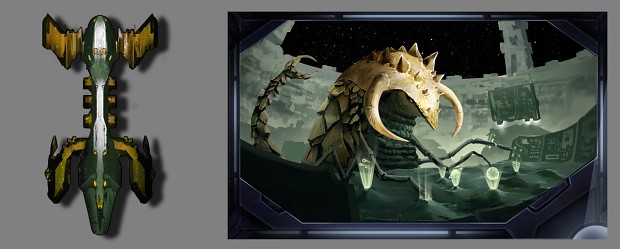
Dravlac:
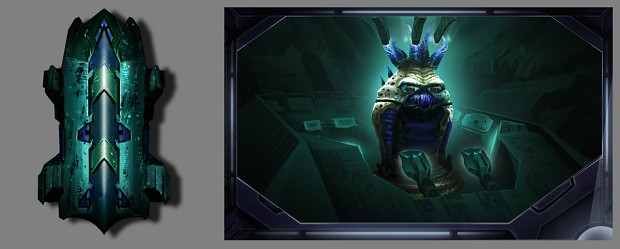
Mooshee:
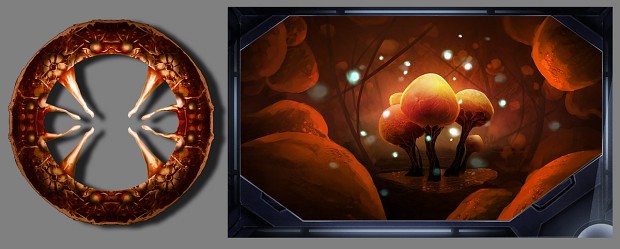
Moknon:
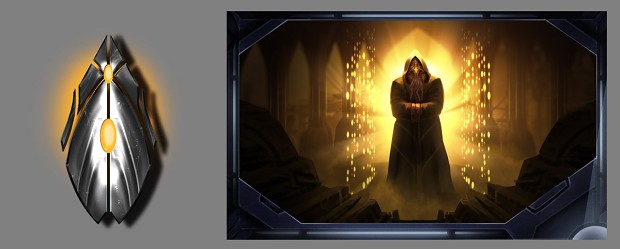
We have also completed our transition from 3d ships to 2d w/ spritelamp light lighting + displacement mapping. I'm very pleased with the results. Once I get a couple of these 2d ships fully moved into the game w/ attacks and AI, I'll post a gif or two of combat.
This last week we finished ship designs for a handful more races.
Krex:

Dravlac:

Mooshee:

Moknon:

We have also completed our transition from 3d ships to 2d w/ spritelamp light lighting + displacement mapping. I'm very pleased with the results. Once I get a couple of these 2d ships fully moved into the game w/ attacks and AI, I'll post a gif or two of combat.
Agreed. I've played both BitTripRunner games and this feels completely different. Also, remember that RUNNER is a rhythm game as well. This is just tackling obstacles as they come. There are videos of blind people getting perfect scores on RUNNER (just from the sound patterns), I don't think they could do that with this game.
That color change mechanic is challenging, though. Fun idea!
EDIT: And by "remember" I mean "allow me to explain" since I just noticed you said you haven't played Bit Trip. Sorry about that.
I never said that I didn't play Bit.Trip. I beat all six original Bit.Trip games lol
GUI programming, anyone?
Thought it would be good in investing some more time in developing a small
graphical user interface to be able to control RSA tool more easily.
Currently, I have only just some loosely coupled (un-managed) windows on the
screen being able to render into them;

However, I want the windows to be manged, a window manager so to speak, being
able to send message and register functions for any event.
What I want to ask is; what are some good practices and things to better avoid
in developing such a GUI? Specifically, am interested in details like good
strategies to manage the windows to provide some good flexibility, and also in
some raster/rendering tricks to allow for more flexibility of the content
being rendered in any of the windows.
Does anyone have some specific experience to share? Thx in advance!
This thing looks too good to not be turned into some sort of IOS/Android app and visualizer plug in for some softwares.
Lord_Balkan
Member
I would say it also depends on what kind of game you want to create.
I have to admit, I've never heard of C4 until today, at first I thought you were talking about Cryengine (they dropped the number now, but it's kind of Cryengine 4 now).
You can cancel your sub and keep whatever version you had when your subscription time ran out. So you could sub once a year to get the most recent updates).
Not sure on this, I suppose you mean you will compare against other titles based on UE4? I personally wouldn't even think about that. There is always someone with a bigger team, more budget etc who will have more impressive games than you. Doesn't necessarily make your game less awesome!
What will your asset pipeline be in C4 like? Does it work well in C4/UE4 for what you want to do?
To be honest, there are currently only two engines I would recommend for 3D games, and those are Unity and UE4. Unity has a huge asset store, huge community and lot's of target platforms. The only reason against Unity (for me) is what visuals it can produce. I've said it many times, but I've yet to see a visual impressive game created in Unity. Then I boot up the UE4 and start the shooter/effects cave sample and think "well this looks sweet for a start".
In terms of the type of game I will create.. C4 and UE4 are pretty even and both are flexible anyway since i have the source. Ive already unsubbed from UE4 so I am prepared about that.
I am not sure what my asset pipeline will look like. I am not am artist, so my proof of concept will contain basic geometric shapes until I am confident in the mechanics. UE4 is much more flexible with art assets and friendlier to artists as well.
I don't want to do it in unity. Access to source code and and being able to modify and implement my own graphical features is important to me. Which is why I invested in C4 a year ago. The graphical capability of C4 is really untapped. Those UE4 demos look awesome but Epic has an army of programmers and artists to showcase its graphical capabilities unlike C4.
Doing something for the intro of Last Knight, I also incorporated that optimization animation effect I showed earlier and I blow it all up. 
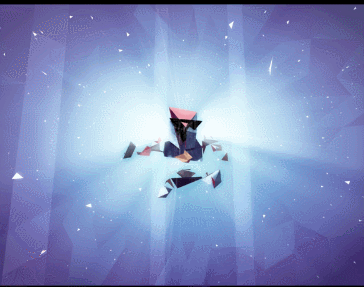
Btw, game is currently on sale on Steam: http://store.steampowered.com/app/262210

Btw, game is currently on sale on Steam: http://store.steampowered.com/app/262210
In terms of the type of game I will create.. C4 and UE4 are pretty even and both are flexible anyway since i have the source. Ive already unsubbed from UE4 so I am prepared about that.
I am not sure what my asset pipeline will look like. I am not am artist, so my proof of concept will contain basic geometric shapes until I am confident in the mechanics. UE4 is much more flexible with art assets and friendlier to artists as well.
I don't want to do it in unity. Access to source code and and being able to modify and implement my own graphical features is important to me. Which is why I invested in C4 a year ago. The graphical capability of C4 is really untapped. Those UE4 demos look awesome but Epic has an army of programmers and artists to showcase its graphical capabilities unlike C4.
Do you plan to make this game alone or is it already quite certain that you might need more people working on the game (that also might have to use C4 then).
Anyway, since you asked to recommend one of those two engines. I would say (from my perspective) that I would ask myself why someone would even use C4.
UE4 is done by huge a dev team which has years of experience in doing engines. They have a big community be on the forums, answer hub (stackoverflow like) or even IRC. It's cheap, you will find people that know the engine much easier than lets say C4 (which I hadn't even heard of until today and I've been following game dev stuff for years). It has a nice content pipeline and tools like Substance designer/Quixel support it. It has people actually releasing games with it on consoles (can't wait for more UE4 games at E3). I mean how many shipped console titles are there with C4?
BUT, I would never really tell anyone what they should use. You know best what your goals are and what skills you have. Maybe C4 is just right for you.If you think C4 just fits your needs well, then go ahead with it.
MrNyarlathotep
Banned
New update to OP, thanks to naumov91! Added the C4 Engine. Never heard of it before, huh!
Hey, if you're updating OP with engines, can I suggest a couple?
Phaser - free and open source HTML5 based game engine
HaxeFlixel - free amd open source cross platform 'port' of Flixel (and probably makes more sense to use than Flixel for most people nowadays)
I never said that I didn't play Bit.Trip. I beat all six original Bit.Trip games lol
Sorry, that was referring to Popyea, not you. Apologies for any confusion.
How do you tackle PR work in small indie dev teams (5-10 persons)? Is it necessary/highly recommended to have a single person do the complete PR work (and nothing else) or do you think it also works if everybody does a part of it (post to Facebook, tweet, etc.)? My team is currently debating whether to look for a person with PR experience or just do everything ourself. Nobody has previous PR experience or industry contacts or something so we're a bit uncertain now.
We're developing an adventure with the Visionaire Game Engine based on the web comic Sandra & Woo. We're currently talking to Daedalic and are aiming for a Steam release next year.
We're developing an adventure with the Visionaire Game Engine based on the web comic Sandra & Woo. We're currently talking to Daedalic and are aiming for a Steam release next year.
Lord_Balkan
Member
Do you plan to make this game alone or is it already quite certain that you might need more people working on the game (that also might have to use C4 then).
Anyway, since you asked to recommend one of those two engines. I would say (from my perspective) that I would ask myself why someone would even use C4.
UE4 is done by huge a dev team which has years of experience in doing engines. They have a big community be on the forums, answer hub (stackoverflow like) or even IRC. It's cheap, you will find people that know the engine much easier than lets say C4 (which I hadn't even heard of until today and I've been following game dev stuff for years). It has a nice content pipeline and tools like Substance designer/Quixel support it. It has people actually releasing games with it on consoles (can't wait for more UE4 games at E3). I mean how many shipped console titles are there with C4?
BUT, I would never really tell anyone what they should use. You know best what your goals are and what skills you have. Maybe C4 is just right for you.If you think C4 just fits your needs well, then go ahead with it.
I may need more people..
I'm a little surprised that you haven't heard of C4. It has been around since like 2005ish or so. The reason I originally chose it was because it was professionally written, gave you full source code and was royalty free.
The indie landscape certain changed with Epic's announcement of UE4. The big thing with me is I have already invested a bit of money into C4 (which I dont regret either way, especially with the lifetime updates and just messing around with it). Also the fact that it is royalty free versus Epic's 5%. C4 is definitely a hardcore programmer's engine and that is just who I am, the only limitations is my skill. UE4s price model allows for that as well.
Basically my investment, and selling games without royalties, along with the awesome support I have received at the C4 forums is making this a tough decision for me.
There are no console games shipped with C4 but also C4 being on PS3 and PS4 is relatively new. Also, Epic's pricing model changes when you deploy on consoles where C4's does not.
The indie game "Mark of the Old Ones" that is on greenlight right now is made using C4.
http://markoftheoldones.com/
You're programming in C++ right?However, I want the windows to be manged, a window manager so to speak, being
able to send message and register functions for any event.
What I want to ask is; what are some good practices and things to better avoid
in developing such a GUI? Specifically, am interested in details like good
strategies to manage the windows to provide some good flexibility, and also in
some raster/rendering tricks to allow for more flexibility of the content
being rendered in any of the windows.
Does anyone have some specific experience to share? Thx in advance!
C++ is a rather poor language for GUI programming. This is why you don't see any of the major GUI toolkits using it. Cocoa is Objective-C, QT uses a special metacompiler to add language extensions to C++, MFC uses special macros while the CLI used Managed C++, Android is Java, etc.. etc..
Actually, looking at what QT uses its metacompiler for might be a good place to start in a way.
That's interesting -- what about C++ makes it poorly suited for GUIs?You're programming in C++ right?
C++ is a rather poor language for GUI programming. This is why you don't see any of the major GUI toolkits using it. Cocoa is Objective-C, QT uses a special metacompiler to add language extensions to C++, MFC uses special macros while the CLI used Managed C++, Android is Java, etc.. etc..
Actually, looking at what QT uses its metacompiler for might be a good place to start in a way.
GUI programming is made easier with things like dynamic typing and reflection. C++ is statically typed and lacking in introspection features. While something like Objective-C allows you to send any message to any object at a runtime cost of course.That's interesting -- what about C++ makes it poorly suited for GUIs?
If you're curious here's a couple interesting articles about how Qt works.
http://woboq.com/blog/how-qt-signals-slots-work.html
http://woboq.com/blog/reflection-in-cpp-and-qt-moc.html (about whether a proposed extension to C++ that may make it into the 2017-ish revision would allow Qt to no longer require the meta-object compiler)
Hey, if you're updating OP with engines, can I suggest a couple?
Phaser - free and open source HTML5 based game engine
HaxeFlixel - free amd open source cross platform 'port' of Flixel (and probably makes more sense to use than Flixel for most people nowadays)
I'd be happy to add them if someone with experience with them wrote up a description. I don't like writing about engines I don't have any hands on time with.
Here's a very late Screenshot Saturday image from my game. I've worked today on making a hint system that's parented to the camera rather than being a 3D text placed on the level itself, making it a whole lot easier to read.

I realized I absolutely had to do this when some playtesters kept trying to attempt an area in the first level that required the brake and failing because they failed to read a huge hint which said "brake: left mouse button". It makes sense since moving around at high speeds makes it kind of hard for players to focus on the hints floating around... unless you'd stop completely for a few seconds to read the hint, therefore wasting time.

I realized I absolutely had to do this when some playtesters kept trying to attempt an area in the first level that required the brake and failing because they failed to read a huge hint which said "brake: left mouse button". It makes sense since moving around at high speeds makes it kind of hard for players to focus on the hints floating around... unless you'd stop completely for a few seconds to read the hint, therefore wasting time.
Teknopathetic
Member
"I'm enjoying Unity for the most part, but am surprised that creating a general game manager is more of a hassle than it should be. Am I expected to create invisible gameobjects to store a bunch of global variables? I sort of wish there was a basic Game1.cs like XNA."
I believe that's one of the most straight-forward ways to do it in Unity. Create a single empty game object with your manager script, tell it not to destroy on load, then have other gameobjects that need to access whatever variables it contains store a reference to it.
I believe that's one of the most straight-forward ways to do it in Unity. Create a single empty game object with your manager script, tell it not to destroy on load, then have other gameobjects that need to access whatever variables it contains store a reference to it.
"I'm enjoying Unity for the most part, but am surprised that creating a general game manager is more of a hassle than it should be. Am I expected to create invisible gameobjects to store a bunch of global variables? I sort of wish there was a basic Game1.cs like XNA."
I believe that's one of the most straight-forward ways to do it in Unity. Create a single empty game object with your manager script, tell it not to destroy on load, then have other gameobjects that need to access whatever variables it contains store a reference to it.
I've been trying a few different methods, some outlined on this page: http://forum.unity3d.com/threads/help-how-do-you-set-up-a-gamemanager.131170/
But yeah... I may just end up going the empty gameobject route. I guess I should just let go and learn to do things the Unity way. Thanks!
Mystic River
Member
Haven't posted for a few weeks, I've been working on adding all the UI functionality, and now players can also customize the color of each module part.
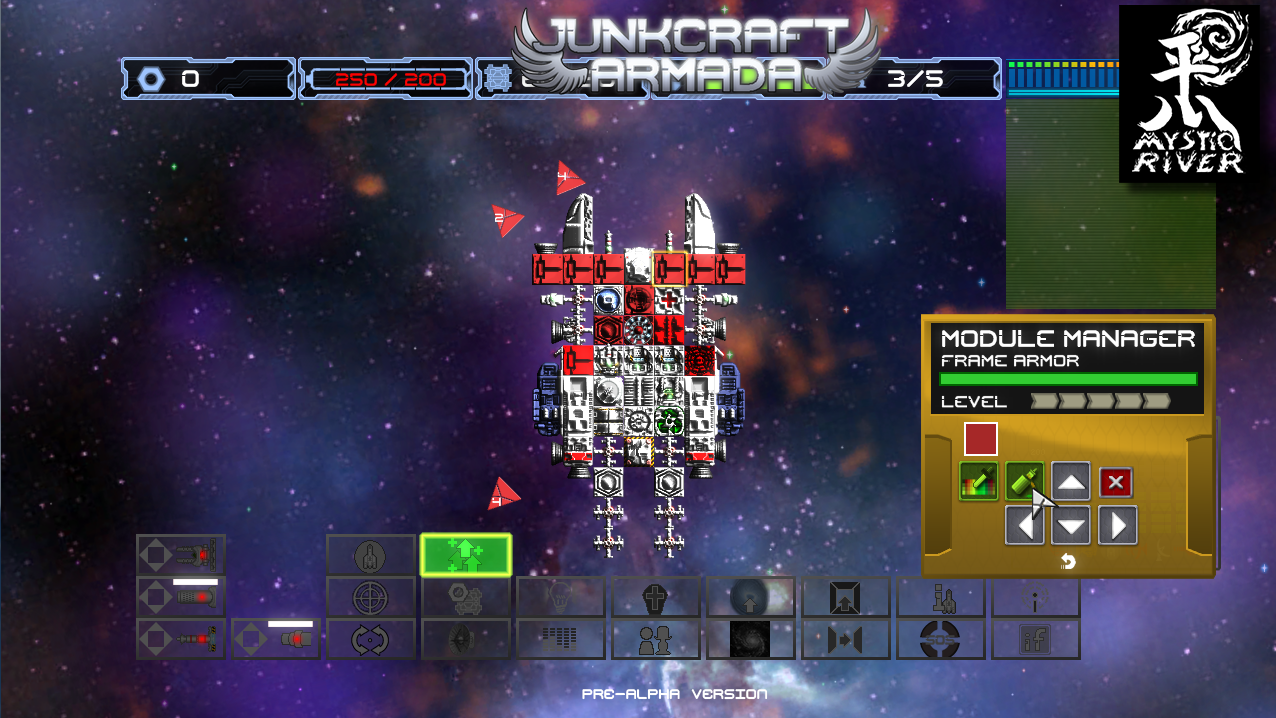
more info at http://www.indiedb.com/games/junkcraft-armada
or my blog at http://mysticrivergames.blogspot.com

more info at http://www.indiedb.com/games/junkcraft-armada
or my blog at http://mysticrivergames.blogspot.com
Sorry, that was referring to Popyea, not you. Apologies for any confusion.
No big man. The more Bit.Trip fans there are the better
Thanks for the reminder! Indeed, complexity rises quickly when implementingLooks wicked man.
As for GUI tips. No implementation advice, but you absolutely must make something super simple, and reuse as much as you can. Flexibility and productivity are key as you'll probably change it around a lot.
something from the ground up if not taking care of right at the start. Making
it super simple yet flexible is perhaps the most difficult part, I guess.
Yeah!This thing looks too good to not be turned into some sort of IOS/Android app and visualizer plug in for some softwares.
pretty good ideas for analyzing and visualizing other things as well.
For example, one can analyze controller inputs (mouse, touch, joystick) and
draw some conclusions from. The data can be used by the AI reading your
"rhythm" resp. adapt to it etc. Or one may use it to optimize control of a
vehicle, which I'm very interested in. For example, one may do a spectral
analysis of the dampers of a vehicle around a track. :+ Different story....
You're programming in C++ right?
C++ is a rather poor language for GUI programming. This is why you don't see any of the major GUI toolkits using it. Cocoa is Objective-C, QT uses a special metacompiler to add language extensions to C++, MFC uses special macros while the CLI used Managed C++, Android is Java, etc.. etc..
Actually, looking at what QT uses its metacompiler for might be a good place to start in a way.
Thanks! I had a look at QT. Looking at QT signals etc. I think I can simplify
it down (for my needs) using C++ templates without needing any MOC. Yet the
creation of GUI elements and signals/methods is just one part. The other part
is window management, layouting, and rendering. I hope I can keep it simple.
C/C++? Right. What I like the most about C/C++ is that it is a language and
not a platform build for a specific purpose or system. That's why C/C++ will
pretty much stay forever. Other languages/packages may be good for developing
GUIs etc., but it always comes as a trade off. And the trade off for me reads;
control (not speaking about the overhead many systems suffer from). For
clarity, it's not may intention to build the most sophisticated or flexible
GUI out there such that I would need programming concepts like dynamic typing
or reflection. I just need a simple, smart, yet very badass GUI!
I've been trying a few different methods, some outlined on this page: http://forum.unity3d.com/threads/help-how-do-you-set-up-a-gamemanager.131170/
But yeah... I may just end up going the empty gameobject route. I guess I should just let go and learn to do things the Unity way. Thanks!
All your system data can go in a static class, so you don't need that attached to a gameobject. The difficulty is in updating that data. What controls that?
I have a three level system. A static class with the data, a 'SuperCoreSystem' bunch of game objects loaded as a scene, and a FlowScript in a CoreGameSystem prefab in my levels. The FlowScript deals with the updating of a level, the SuperCoreScript deals with startup profile loading and level switching, and the static class just holds data.
It's a bit of work to get going, but it's a shit hot solution once you do! You can run from any scene in your project and it's as if you ran properly from boot, with your profile set up and everything. And it's a super slick method for async loading between menus and levels, and so on...
More details...
I have a root object in all my scenes with a high priority script on that object. The object disables everything below it in its Awake method, then notifies a static class that its been loaded, and sends a heartbeat every update. The static class is then responsible for async additively loading my SuperCoreSystem scene, that has all the core parts of the game structure in it. When the core is loaded, it initialises itself and then the original scene is told to wake up. The SuperCoreSystem keeps a reference to the root object in the level, and uses that do inform of level transitions, and ultimately destroys the old level once the new one is loaded up.
This system lets me tag each scene with game state data. So, if I run from a game level, the game starts up as if I went through the main menus and picked a level.
The cool thing is that I'll put my loading screen in the SuperCoreSystem, and it'll manage async loading between different scenes, as it'll always be loaded into memory.
I guess you could implement this by loading a 'system' resource on awake in each of your scenes if they fail to find an existing one.
The obvious alternative is to add a 'system' prefab to each of your levels. But then you'll have to mark them as don't destroy on load, and destroy new ones if they find an existing one.... messy.
Hope that in some way helps!
That's interesting -- what about C++ makes it poorly suited for GUIs?
I've written lots of UI in C++. You can do anything in C++. You just have to write it all yourself, which means you can do whatever you want!
- Status
- Not open for further replies.
